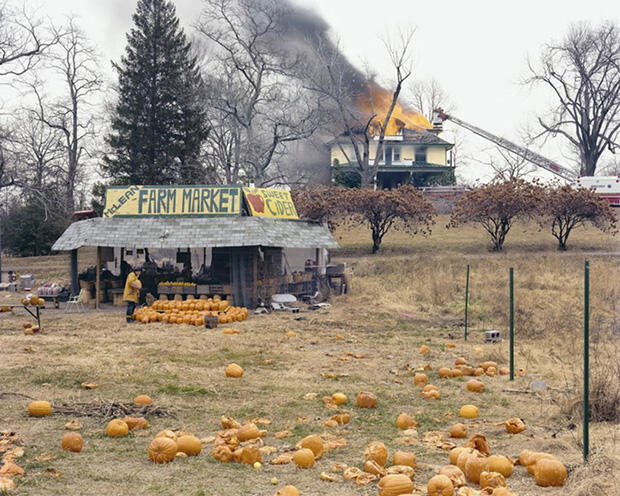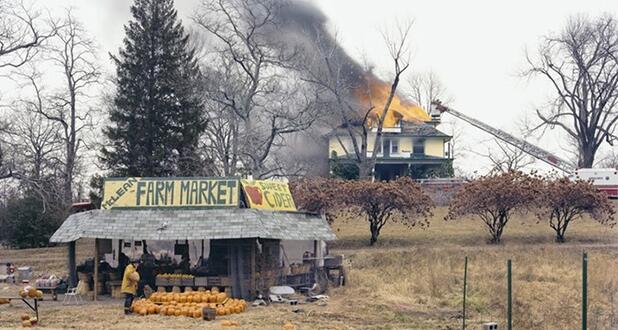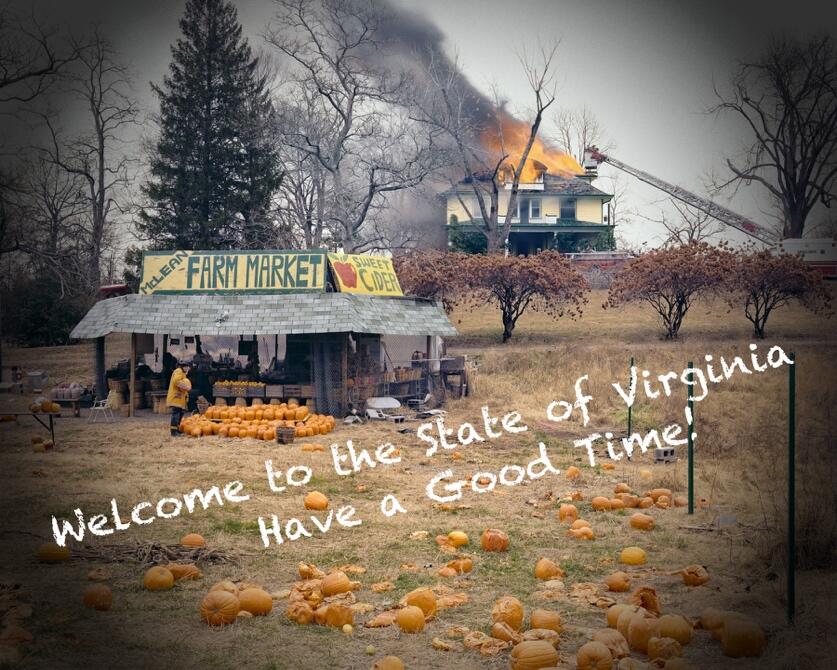Introduction
Joel Sternfeld is considered one of the first artists to try color photography, with his works focusing on the exploration of the American psyche of the late 1970s and the 1980s. This period in U.S. history was associated with doubt and reflection, especially for the Western part of the country, and Sternfeld managed to capture this issue in his most notable work, American Prospects. For this analysis, a closer look will be given at the photographer’s famous image – McLean, Virginia, December 1978 (Figure 1).

Description
In the image, an observer can see a firefighter at a local farmer’s market buying pumpkins. In the background, a large house is burning down. The photograph is framed in such a way that immediate attention is given to the pumpkin stand. This creates an illusion of a stereotypical image of fall in America. However, as one looks more attentively, the glance travels to the building in flames, with firefighters on the roof trying to put the fire down. The elements of the photograph are arranged closely with little negative space between them. If one is to crop the main aspects of the image, the farmer’s market and the burning building can fit in a smaller frame compared to the actual size of the photograph.
In regards to focus, pumpkins scattered on the ground were the closest to the photographer and thus appear sharper and clearer. The natural light of gloomy fall day made the photograph well-lit but not bright or overly exposed. The light grey sky serves as a background for the main composition, making colors less vibrant and leaning to sepia tones. The darkest spots on the image include the market and the burning building as well as some of the trees in the background.
There is still a noticeable contrast of several colors: the yellow-orange of the pumpkins against the barely green grass, the yellow sign of the farmer’s market against the dark greys, browns, and greens of the trees, and the yellow-orange flames against the light grey sky. These contrasts give the image the texture and character that many will associate with fall.
It is interesting to explore the angle of the image. The perspective and framing point to the idea that the photographer was passing by the area and noticed an interesting scene. It is also likely that the picture was taken from an area that was a little higher than the market. However, no special strategies to take the perfect staged photo are present, which suggests that it was spontaneous and far from being impeccable. Since Sternfeld’s image is so fascinating, one may theorize about the changes in its meaning if some of the elements were different. If, for example, the firefighter was watching the house burning down, this would have shown a feeling of worry. He would have likely also been the key focus of the entire photo, with his yellow jacket standing out against the greys and dark greens of the landscape.
The photograph also pays attention to the beauty of the landscape regardless of the strange situation with the fire. The colors are beautiful and harmonious, typical of a traditional American fall. However, this beauty is complicated by the bright fire; while it is said that it is possible to watch a fire burn for a long time, the same cannot be said about a burning house. Overall, the essential aspects of the landscape include scattered pumpkins, the line of trees in the front of the burning building, the farm stand, and trees in the background, and the house. These elements are working together to create a peaceful but shocking landscape of American fall.
Analysis
Playing with composition is an interesting task because it allows us to interpret something in a new way or give it a deeper meaning. When cropping Sternfeld’s photograph, it was chosen to remove the scattered pumpkins in the front of the picture. This led to the image getting a horizontal orientation rather than a vertical (Figure 2). Also, it preserved the main elements: the farmer’s market and the burning house. In this way, the first look on the image does not focus on the beautifully scattered pumpkins but rather goes straightaway to the focal points of the composition.

The image generated above is rather mundane and less interesting compared to the original, which means that the photographer’s artistic value should not be overlooked. However, it is more straightforward and less complex in composition. It should also be mentioned that cropping the image allowed the house to be placed almost in the center of the composition, giving it more attention. In addition, the horizontal orientation of the image goes with the line of trees to the right of the farmer’s market. In this way, they are in the center from the top and bottom edges and create a point of balance between the house and the market. The trees also cut between the chaos of the fire and the peacefulness of the market.
Greeting Card

The greeting card seen in Figure 3 above takes advantage of the surprise and contradiction inherent to Sternfeld’s photograph. A vignette filter was chosen to focus the attention of the viewer on the events depicted in the image. In this way, one’s glance is oriented on the area that appears lighter, while non-important aspects of the landscape are darker. This effect also gives the appearance of an aged photograph.
In terms of the greeting itself, “Welcome to the State of Virginia” was the first phrase that came to mind because the photo was taken there and can somewhat represent it. “Have a Good Time” was added as a sarcastic joke since the image shows fire and a bystander that seems not to care about it at all. This greeting card can be indeed given to someone visiting Virginia both as a joke and as a reminder of the complex social issues that persist in the country.
Conclusion
In summary, Sternfeld’s McLean, Virginia, December 1978 should never be cropped or altered. The photograph is balanced in many ways: from the color palette to the contrast between the good and the bad. Although, it should be mentioned that the fire was controlled and used for firefighter training, which is why the man in the market may not be interested in it. Despite this, there is still deeper meaning to the photograph analyzed in this paper: a person always cares about one’s own affairs than about what is going on in the world.
Reference
McLean, Virginia, December 1978 [Image]. (n.d.). Web.